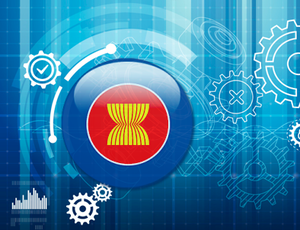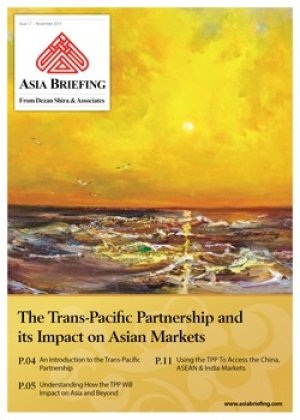The ASEAN Economic Community and What it means for Intellectual Property
 By the South-East Asia IPR SME Helpdesk
By the South-East Asia IPR SME Helpdesk
In 2015, the ASEAN Economic Community (AEC) was officially fully established. In some ways similar to the economic unity of the EU, the broad aims of the AEC are to develop (1) a single market and production base, (2) a region of more equitable economic development, and (3) a globally integrated economic region. To achieve these, trade barriers will be removed or reduced and standards across a number of sectors (i.e. cosmetics, pharmaceuticals, agricultural products, and medical devices) will be harmonized.
ASEAN Economic Community and the IPR
Preparing for this level of economic integration is no simple task, not least in terms of IPR, which has been the focus of five strategic goals for the 2011-2015 period:
- A balanced IP system that accommodates varying levels of development of member states, including IP institutions, to make the region favourable to IP holders and creators.
- Development of national or regional legal and policy infrastructures that can deal with an ever-changing IP landscape and enable ASEAN states to participate in global IP systems.
- Systematic promotion of IP creation, awareness and utilisation, so that IP becomes a tool for innovation and development.
- Active regional participation in the international IP community, to develop the capacity of member states and to address the needs of stakeholders in the region.
- Intensified co-operation among member states and increased levels of collaboration to enhance the human and institutional capacity of IP Offices in the region.
The implications for IP rights holders
Notwithstanding the concerns over whether every state can bring their IP institutions up to the required standards, the establishment of the AEC will almost certainly make IP protection even more, rather than less of an issue for foreign businesses. ASEAN will not go as far as the EU towards unlimited free movement of goods, but there will still be a significant increase in the movement of all types of goods, increasing the potential for international trade in counterfeits.
In theory, IP protection should be self-regulating: with the freer movement of capital and investment as a target, investment may not follow if protection is weak in a certain country. In reality a lag in the development of IP institutions should be anticipated, so there are some key points concerning the region’s IP systems to keep in mind.
Firstly, there are no plans to introduce a ‘Community Trade Mark’ or regional patent to the AEC. Consequently, an IP rights holder needs to register in each country in which they seek protection. Additionally, it is advisable to consider individual trade secret and copyright laws, as it may soon be possible to record these at a national level in all states.
Secondly, the AEC ‘Single Window’ for Customs means that, as in the EU, foreign goods will enter the AEC market via one Customs entry point, and are then free to circulate around the AEC with no additional border checks. This means that a business’ goods are now far more likely to be sold in an AEC country they have not anticipated or intended. Therefore protection in multiple countries should be carefully considered.
Thirdly, it is wise to be aware of the differences between individual states. Some ASEAN member states like Singapore and Thailand are considered to be regional leaders in IPR, to the extent that Singapore has become a global IP trading hub. While others are still advancing their legal regimes – the Philippines has recently enacted several policy initiatives to allow ratification of several international IPR treaties, such as the Nice Agreement on the classification of goods and services in trade mark applications, accompanied by a well-publicised customs crackdown on counterfeits. As such businesses should be aware of higher risk territories and prioritise timely prevention measures in these.
The risk of counterfeiting exists across all of ASEAN. Thailand, Vietnam and Indonesia are a major source of, and destination for counterfeits, though the majority of counterfeit goods are still imported from China. Singapore is a small market for counterfeits, but as a large port receiving many goods from China, it still serves as an entry- and transit-point for infringing goods. The AEC will be a turning point for the Southeast Asian business environment, but businesses should not assume that risks to their IP assets will be immediately reduced by AEC measures – diligence and a sound protection strategy will be even more vital in the near future.
|
The South-East Asia IPR SME Helpdesk, co-funded by the European Commission’s Directorate-General for Enterprise and Industry under the Competitiveness and Innovation Framework Programme, supports European Union (EU) small and medium sized enterprises (SMEs) to both protect and enforce their Intellectual Property (IP) rights in or relating to South-East Asia, through the provision of free information and services. These take the form of jargon-free, first-line, confidential advice on intellectual property and related issues, plus training, materials and online resources.
|
Annual Audit and Compliance in ASEAN
For the first issue of our ASEAN Briefing Magazine, we look at the different audit and compliance regulations of five of the main economies in ASEAN. We firstly focus on the accounting standards, filing processes, and requirements for Indonesia, Malaysia, Thailand and the Philippines. We then provide similar information on Singapore, and offer a closer examination of the city-state’s generous audit exemptions for small-and-medium sized enterprises.
 The Trans-Pacific Partnership and its Impact on Asian Markets
The Trans-Pacific Partnership and its Impact on Asian Markets
The United States backed Trans-Pacific Partnership Agreement (TPP) includes six Asian economies – Australia, Brunei, Japan, Malaysia, Singapore and Vietnam, while Indonesia has expressed a keen willingness to join. However, the agreement’s potential impact will affect many others, not least of all China. In this issue of Asia Briefing magazine, we examine where the TPP agreement stands right now, look at the potential impact of the participating nations, as well as examine how it will affect Asian economies that have not been included.
 An Introduction to Tax Treaties Throughout Asia
An Introduction to Tax Treaties Throughout Asia
In this issue of Asia Briefing Magazine, we take a look at the various types of trade and tax treaties that exist between Asian nations. These include bilateral investment treaties, double tax treaties and free trade agreements – all of which directly affect businesses operating in Asia.









